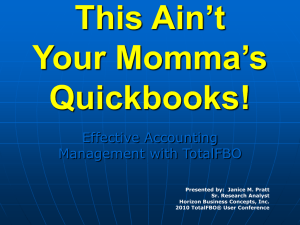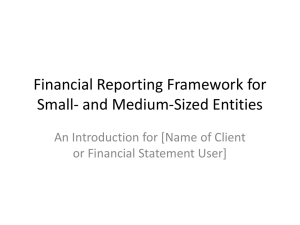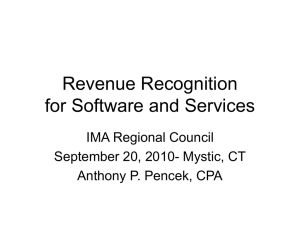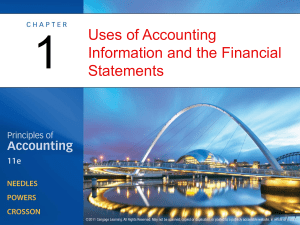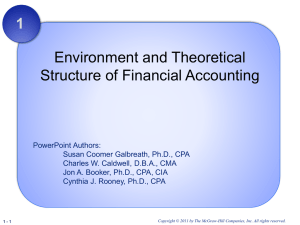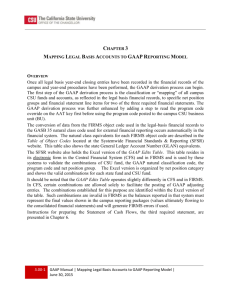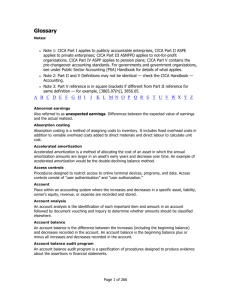Chapter 5
advertisement
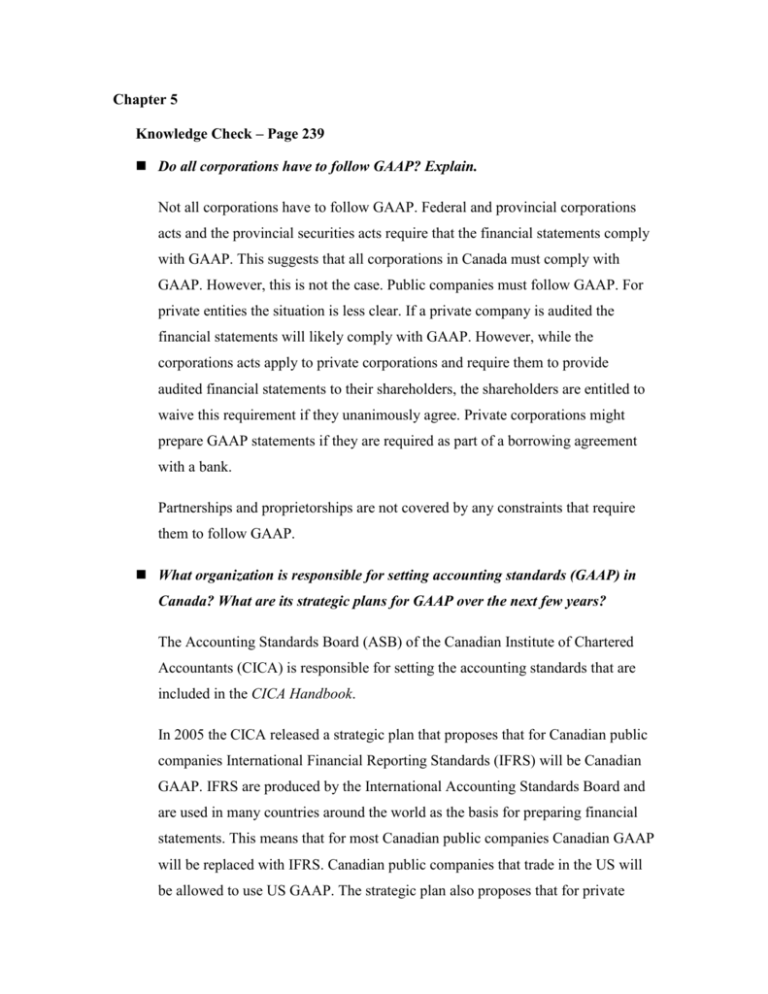
Chapter 5 Knowledge Check – Page 239 Do all corporations have to follow GAAP? Explain. Not all corporations have to follow GAAP. Federal and provincial corporations acts and the provincial securities acts require that the financial statements comply with GAAP. This suggests that all corporations in Canada must comply with GAAP. However, this is not the case. Public companies must follow GAAP. For private entities the situation is less clear. If a private company is audited the financial statements will likely comply with GAAP. However, while the corporations acts apply to private corporations and require them to provide audited financial statements to their shareholders, the shareholders are entitled to waive this requirement if they unanimously agree. Private corporations might prepare GAAP statements if they are required as part of a borrowing agreement with a bank. Partnerships and proprietorships are not covered by any constraints that require them to follow GAAP. What organization is responsible for setting accounting standards (GAAP) in Canada? What are its strategic plans for GAAP over the next few years? The Accounting Standards Board (ASB) of the Canadian Institute of Chartered Accountants (CICA) is responsible for setting the accounting standards that are included in the CICA Handbook. In 2005 the CICA released a strategic plan that proposes that for Canadian public companies International Financial Reporting Standards (IFRS) will be Canadian GAAP. IFRS are produced by the International Accounting Standards Board and are used in many countries around the world as the basis for preparing financial statements. This means that for most Canadian public companies Canadian GAAP will be replaced with IFRS. Canadian public companies that trade in the US will be allowed to use US GAAP. The strategic plan also proposes that for private companies with significant external stakeholders (such as bankers), a new set of accounting standards will be established that would be designed to meet the needs of these private business entities. For private entities whose financial statements are not used for external reporting purposes the strategic plan proposes removing GAAP as a constraint altogether. In addition GAAP for not-for-profit organizations are expected to converge with the international standards. The CICA intends to have its plan implemented by 2011. Identify and briefly explain the four basic assumptions that underlie GAAP. Unit of Measure: The unit-of-measure assumption states that the economic activity of an entity can be effectively stated in terms of a single unit of measure. The unit of measure that is almost always used is money, and in Canada the monetary unit used is usually the Canadian dollar Entity: The financial statements of an entity should only provide information about that entity. Transactions and economic events that do not pertain to that entity should be excluded. Going Concern: A going concern is an entity that will be continuing its operations for the foreseeable future. GAAP assumes that, absent evidence to the contrary, an entity operates as a going concern. This means that an entity is expected to complete its current plans, use its existing assets, and meet its obligations in the normal course of business. Periodic Reporting: The periodic-reporting assumption states that meaningful financial information about an entity can be provided for periods of time that are shorter than the life of an entity. Knowledge Check – Page 243 What is comparability and why is it important according to GAAP? Comparability means that stakeholders should be able to compare the accounting information provided by different entities and compare the information of a particular entity from period to period. Comparability is important because accounting numbers are very difficult to evaluate in absolute terms. It is necessary to have benchmarks or bases of comparison to make sense of the numbers. Identify and briefly explain the characteristics that, according to the CICA Handbook and GAAP, make accounting information relevant. The CICA Handbook describes three characteristics that contribute to the relevance of information: Predictive value: Many decisions that stakeholders make involve predicting the future. Financial statement information should help stakeholders predict future earnings and cash flows. Feedback value: When users make predictions, they require information that allows them to evaluate their predictions and to revise, update, correct, and adjust them. GAAP-based accounting is reasonably well suited for providing feedback because it presents the results of what happened. Stakeholders are then able to compare the actual results with their predictions. Timeliness: For information to be useful for decision making it must be available to stakeholders in time to influence their decisions. Identify and briefly explain the characteristics that, according to the CICA Handbook and GAAP, make accounting information reliable. The CICA Handbook identifies the following components of reliability: Verifiability: Information is verifiable if independent and knowledgeable observers can come up with the same results for the measurement of an attribute. Representational faithfulness: Representational faithfulness refers to the association between underlying information being represented and the representation of that information. Financial statements are a representation of the underlying economic activity of an entity. If the statements are to be representationally faithful, then they must capture the economic activity of an entity. Neutrality or freedom from bias: Information is neutral or free from bias if it is not presented in a way that is designed to bias or manipulate users’ decisions. Knowledge Check – Page 251 What is matching? Why does matching make it necessary to estimate future costs in some situations? Matching is the process of associating costs (based on the historical costs) with the revenue the costs help earn so that income can be determined. Matching gives rise to the need to estimate expenses because some expenditures are not made until after the revenue is recognized but these must be accrued at the time the revenue is recognized. What is conservatism? Why does conservative accounting in the present sometimes lead to non-conservative results in the future? Conservatism requires that measurements in financial statements should be made to ensure that assets, revenues, and net income are not overstated and that liabilities and expenses are not understated. Conservative accounting in the present sometimes lead to non-conservative results in the future because accounting is a zero-sum game. By, for example, making a more conservative estimate of expenses today (meaning a higher estimate), there will be fewer expenses to be made in the future. Total expenses over the life of the entity will be the same, but the timing of recognition is affected. Why does the existence of non-arm’s length or related party transactions make it possible that the reporting entity’s financial statements will be difficult to interpret? When transactions take place between related parties it can’t be assumed that the transaction amount is the fair market value. An implicit assumption about GAAP financial statement is that transactions and economic events take place at arm’s length and are recorded at fair market value. If this assumption is not followed financial statements will be difficult to interpret because it will not be possible to tell if the financial statements are representative of economic activity recorded at fair value.
